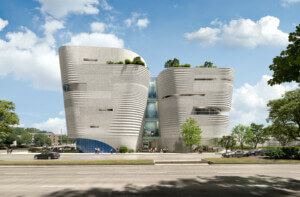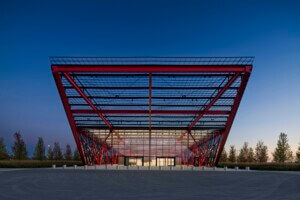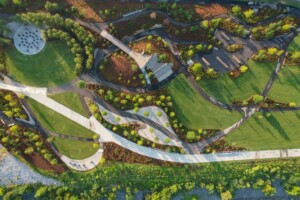The Mitchell Park Domes have been an iconic and well-loved part of the Milwaukee skyline for several generations. As of February 9th, the Domes are closed to the public amidst reports of falling concrete, and their future is unknown.
Built in stages between 1959 and 1967, the three domes were designed by local architect Donald Grieb, who took inspiration from a contemporary architect and engineer, Buckminster Fuller. Fuller’s office declined to partner with Grieb, noting that they did not want to alter the design of the structures they were working on. At the Mitchell Domes, Grieb made two important innovations to typical geodesic domes of the period.
First, they are considered to be the first conoidal glass domes ever built – meaning they have an elongated vertical axis (140 feet in diameter and 85 feet high), making them proportionally taller than typical half-spherical domes.
Second, the substructure was made of reinforced precast concrete – as opposed to bare steel or aluminum components. The domes were built in the age some important technological advancements in concrete, and one in which the likes of Le Corbusier and Eero Saarinen were creating innovative forms out of the material.
The structural ribbing consists of cast on site steel reinforced concrete units. These members are welded to steel plates, also encased in concrete, which give a monolithic appearance from the inside. Over the top of each dome is a triangulated aluminum and glass skin, connected to the concrete frame by stainless steel hubs.
One disadvantage of this uninsulated concrete structure is its susceptibility to water. Water working its way into cracks in concrete, corroding its steel reinforcement, has caused expansion and spalling. The glass skin on each Dome is designed to be watertight and has an internal drainage system for condensation, yet with age water has found its way into any building – through cracks in the glass and clogged drains. The Tropical Dome maintains 80 degrees and 85 percent humidity, putting the concrete at risk from the beginning.
Since 1994, the domes have undergone numerous repairs and renovations. In 2008 a major renovation involved remodeling the lobby, replacement of hundreds of cracked glass panels, and the addition internal lighting that gave the structures a more defining presence at nighttime.
Milwaukee County, the owner of the domes, spent $200,000 on concrete repairs in the Tropical dome between 2013 and 2014, and in 2015 had flagged another $500,000 for a structural study and to install protective nets. Local engineering consulting firm GRAEF USA was hired to analyze the existing structure and propose a fix. The severity of the crumbling concrete led to the closing of the Arid Dome on January 28th.
A week later, the County made the decision to close the domes indefinitely, until short term and long term solutions can be evaluated. According to County Executive Chris Abele, the long term recommendation is for a complete reconstruction of the three domes, at an estimated cost between $65–75 Million.
The proposed short term fix involves wrapping thousands of concrete members to contain spalled concrete, which has been reported to be as large as a man’s hand. Milwaukee County has reason to take major precautions with its infrastructure. In 2010, a massive concrete slab fell from the entrance to the County-owned O’Donnell parking structure, killing a 15-year-old boy and injuring two others.
The Milwaukee County Board has announced a Public Hearing on February 24th to discuss the future of the domes. In the meantime, the issue was quick to become politicized in the upcoming race for County Executive, as Chris Abele’s challenger blames him for not investing in the city’s public infrastructure.










